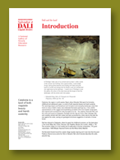
Salvador DALÍ
Spanish 1904–89, worked in United States 1940–48
The disintegration of The persistence of memory 1952–54
oil on canvas
25.4 x 33.0 cm
The Salvador Dalí Museum, St Petersburg, Florida
Worldwide Rights: © Salvador Dalí, Fundació
Gala-Salvador Dalí, VISCOPY, 2009.
In the USA: © Salvador Dalí Museum Inc.,
St. Petersburg, FL, 2009
Dalí’s interest in science was a life long-affair and in 1935 he described himself as a fish swimming between ‘the cold water of art and the warm water of science’. From a young age Dalí was a voracious reader of science and came to own many books on physics, geometry, optical science, genetics, mathematics and natural history. In practice and in his writings Dalí subscribed to the Renaissance view, that men should acquaint themselves with all aspects of knowledge.
Like the Renaissance artist Leonardo da Vinci before him, Dalí’s interest in even the most theoretical scientific subjects was never abstract, but was driven, rather, by a curiosity about how to apply such principles to his art. In the 1920’s, for example, Freud’s theories about dreams and the human unconscious were published in translation. Dalí used Freud’s principles of psychoanalysis on himself and painted the results with a scientific rigour and precision.
Dalí sought above all clarity in his painting and in his thought, even though he was also a champion of irrationality. His painting never loses its tight, meticulous handling and its focus on detail. It is as though he was striving to achieve a perfection in the logic and handling of his pictures equal to the perfection of a mathematical equation. Dali’s fusion of science and art peaked in the 1970s, in a series of optical illusions that outstrip the realism of photography.
Although Dalí was frightened by many things in his life, science was never one of them. In the 1950s he embraced the first nuclear explosions enthusiastically and without fear, much as he had tackled the sexual theories of Freud three decades earlier. For Dalí, nuclear science, like psychoanalysis, uncovered the underlying structure of things, and made possible a whole new level of precision in their artistic rendition. Dalí met with many leading scientists to discuss how art and science might intersect. Becoming religious in later life, Dalí even hoped that ‘divine mysteries’ might be unlocked through science and then represented on canvas. He died with books of science at his bedside.


